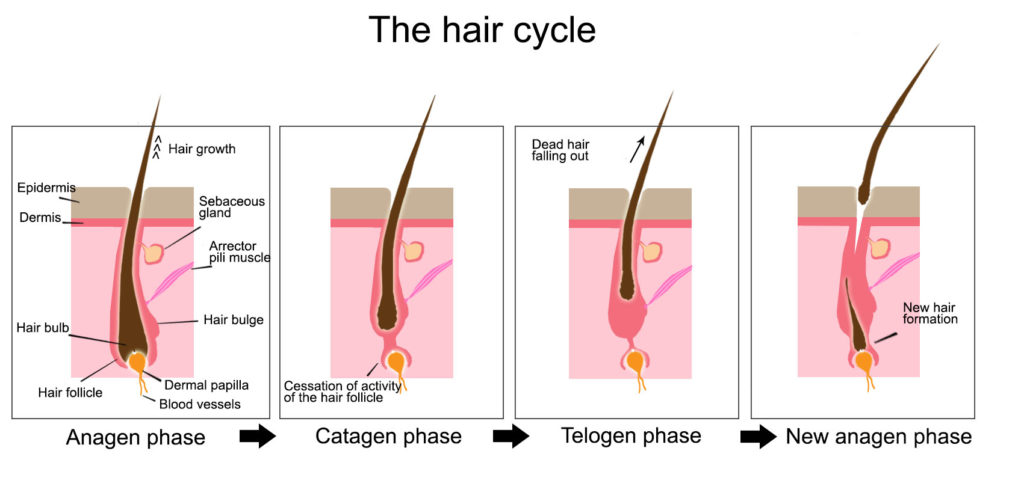Alopecia – Telogen Effluvium
Telogen Effluvium: A Type of Alopecia
Telogen Effluvium is a common type of hair loss or alopecia, but it has hundreds of causes. In our first post in this series, we discussed the hair cycle. As a recap, all hairs on the body generally go through three stages: Anagen, catagen, and telogen. Anagen is the active growing stage. Catagen is the transition stage. Telogen is the resting phase. Every day, about 100 hairs shift into the resting phase, 100 hairs fall out, and 100 others kick back into the active growing phase. Most types of hair loss are a problem with the telogen or resting phase.
Why Does This Occur?
Scientifically, telogen effluvium occurs when too many hairs are in the resting or telogen phase. Hairs shift into the telogen phase and eventually fall out. In the normal hair cycle, telogen hairs naturally kick back into the actively growing anagen phase and start growing again. “Thinning” and loss of hair is noticeable when an excess number of hairs remain in the telogen phase and don’t start actively growing again. This can occur for many reasons including stress, medical problems, medications, pregnancy and more. To simplify things, we will break telogen effluvium into two main types – Acute and Chronic. This short post cannot possibly address everything known about telogen effluvium. However, it will address most of what I discuss in the office about telogen effluvium each day.
Acute Telogen Effluvium
Acute telogen effluvium occurs after a single event. Following pregnancy, delivery, surgery, severe stress and accidents, an excessive number of hairs shift into the telogen or resting phase. This usually is noticed 2 to 3 months after the inciting event, when all the hairs in the telogen phase start falling out as new anagen actively growing hairs replace and push them out. Telogen effluvium can cause loss of thousands of hairs in a short period of time. This is quite alarming to patients. However, acute telogen effluvium is usually a single event. Hair follicles often naturally recover. As hairs regrow, there is a collection of short stubbly hairs at the part and the frontal hairline. Recovery takes time as hairs grow about a centimeter a month. It can take a year or more to get hair looking normal again. If patients are concerned, I often recommend Biotin and Rogaine to encourage anagen growth until hair is back to its normal appearance.
Chronic Telogen Effluvium
Chronic telogen effluvium occurs when an ongoing problem causes hairs to repeatedly and continually shift and STAY in the telogen or resting phase in excessive numbers for more than six months. This can be caused by ongoing medical problems, stress, hormonal changes, dietary changes and more. In chronic telogen effluvium, the challenge is to identify the cause and eliminate it. This can be very difficult, especially since it takes at least six months to see a considerable change in the hair once the chronic problem is resolved.
Finding the Source
The detective game includes investing the preceding six months for :
-changes in medications.
-hormonal changes and supplementation
-changes in diet or herbal supplementation
-medical causes often requiring blood work including checking the kidneys, liver, thyroid, blood count, vitamin D, lupus screening and possibly zinc and ferritin.
-major stressors.
How to Treat
Unlike acute telogen effluvium, in chronic telogen, effluvium hair follicles are less likely to recover spontaneously, even once the inciting problem is resolved. I often recommend Biotin and Rogaine to encourage anagen growth until hair is back to its normal appearance. Once it appears normal, decrease to once a day and taper off Rogaine over six months. If significant hair loss recurs after Rogaine use is ceased, repeat the investigative process or resume Rogaine. As hairs regrow, there is a collection of short stubbly hairs at the part and the frontal hairline. Recovery takes time as hairs grow about a centimeter a month.
Share the Knowledge!
If you find these blog posts helpful, please share them on Facebook, Twitter or your social media preference using the buttons above. Also, you can email them to a friend.
If you would like to receive these posts in your email inbox Subscribe to our Site by clicking on this link.
